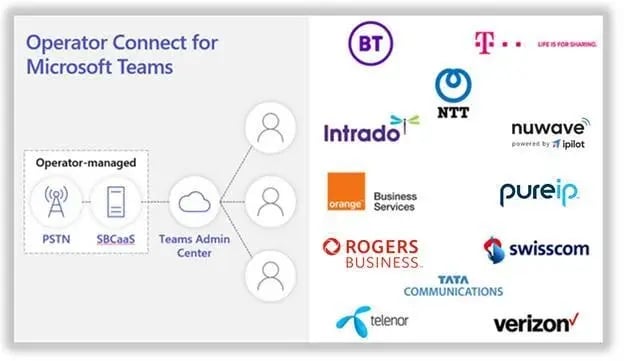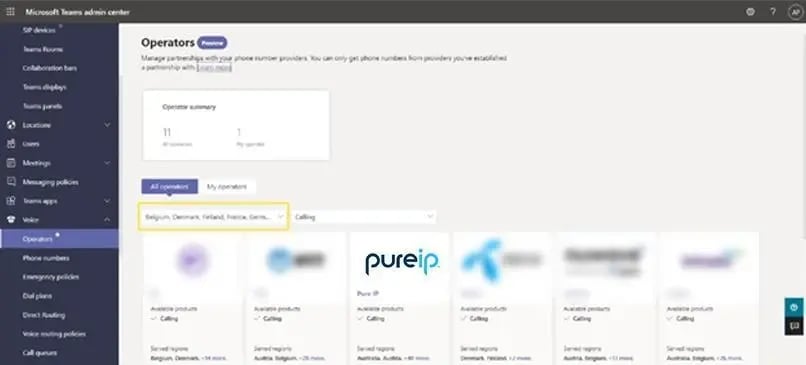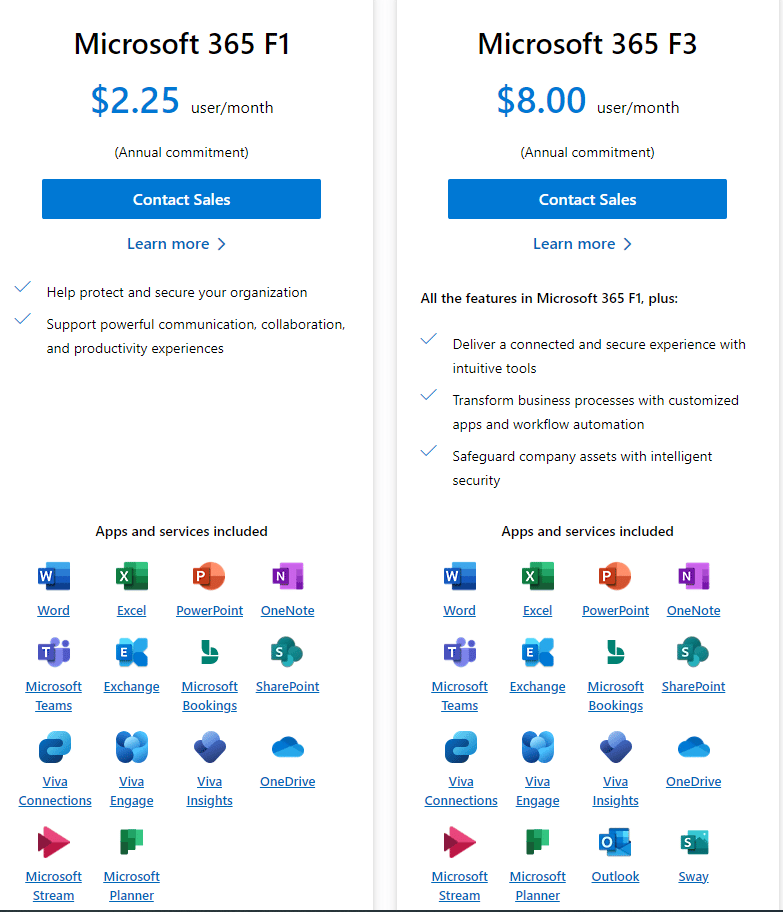How does Microsoft
Operator Connect work?
Before you get started with Operator Connect, there are some prerequisites. You must have the following:
- Teams Phone for all users who need to make and receive external calls
- TeamsOnlyMode enabled for all users who need to make and receive external calls
Once you have these in order, it’s time to select an operator. If you already have a contract with a provider of Operator Connect, this is the most common use case.
To get onto Microsoft’s Operator Connect program, vendors must comply with certain technical and contractual requirements:
- Direct peering through Microsoft Azure Peering Services (MAPS) for Voice
- Ability to offer end-to-end QoS to customers
- SLA to customer
- Be capable of providing phone numbers and PSTN services
- Be regulated/licensed to provide such services
- Have at least two individuals pass the Practical Guidance Assessment for Voice
- Have at least two individuals with Microsoft 365 Certified: Teams Administrator Associate
- Be able to provide Tier 1 customer support
- Meet the requirements related to interconnection, architecture, and integration
If your operator is on the Operator Connect program, they have already conducted the relevant onboarding with Microsoft to agree direct peering and establish a service level agreement.
You get a fully managed and integrated experience while benefiting from shared technical support, discounted calling (compared to Microsoft’s retail price), and custom PSTN features.

What’s more, you can provision these calling services, direct from your preferred operator, via the Teams Admin Center (TAC). That means you get instant access for new numbers and to make moves, adds, and changes.
How do I set up Operator Connect?
1. Assuming you’ve got an agreement with an operator, head to the TAC and choose Voice then Operators.
Under the All Operators tab, filter by region or service then select your operator.
Note: if you don’t have an operator already, contact Pure IP to see if we’re a good match.
In the TAC, select the operator of your choice then the countries you wish to enable.

2. Next, provide your contact information and accept the data transfer notice.
3. Select Add your operator then Add as operator to save the change.
That’s it! You’ve added an operator and can now go about setting up new numbers, emergency information, and managing existing phone numbers.
Need a step-by-step guide for adding an operator? Read our guide: How to use Operator Connect for Microsoft Teams step-by-step
Sounds like Microsoft Calling Plan? Sure. A little. You get the TAC access to make small changes with Calling Plan but you don’t get further customizations enabled by your third-party carrier.
Benefits of Operator Connect include:
- Integration of voice applications
- Support for hybrid environments
- Support for contact centers
- Bundled or discounted pricing
- Potential for global coverage (depending on the operator)
How much does Microsoft Operator Connect cost?
Operator Connect costs vary based on a number of factors. There is no charge for Operator Connect itself. But there are three things you need to consider when calculating your cost of Operator Connect:
- Teams Phone licenses
- Number and call path rental (might be bundled)
- Cost of per call or bundled minutes
What license is required for Operator Connect?
To get Teams Phone access, you’ll need either Office 365 E3 + Teams Phone Standard or Office 365 E5. These costs are broken down in the table below.
Your move to Operator Connect is a great time to audit and consolidate your Microsoft licenses to see if you’re operating at optimum costs and not overpaying for features and services that don’t get used by some users.
| License |
Cost |
Description |
Office 365 E3 + Teams
Phone Standard |
$36 per user per month |
Includes PSTN Audio Conferencing |
| Office 365 E5 |
$57 per user per month |
Includes Teams Phone standard and PSTN Audio conferencing |
If you have users who are frontline workers, you may choose to opt for the F1 or F3 license.
These are slightly reduced licenses, with Microsoft recognizing that information (desk-based) workers have different requirements to mobile and frontline workers.

Which countries is Operator Connect for Microsoft Teams available in?
| |
|
|
|
|
| Argentina |
Dominican Republic |
Japan |
Poland |
Svalbard |
| Australia |
Estonia |
Kenya |
Portugal |
Sweden |
| Austria |
Finland |
Latvia |
Puerto Rico |
Switzerland |
| Belgium |
France |
Lithuania |
Romania |
Thailand |
| Brazil |
French Guiana |
Luxembourg |
Rwanda |
Uganda |
| Bulgaria |
Germany |
Martinique |
Reunion |
United Kingdom |
| Canada |
Greece |
Mayotte |
Saint Barthelemy |
United States |
| Chile |
Guadeloupe |
Mexico |
Saint Martin |
Zambia |
| Colombia |
Hong Kong |
Netherlands |
Singapore |
Zimbabwe |
| Costa Rica |
Hungary |
New Zealand |
Slovakia |
|
| Croatia |
India |
Norway |
Slovenia |
|
| Cyprus |
Ireland |
Panama |
South Africa |
|
| Czechia |
Israel |
Peru |
South Korea |
|
| Denmark |
Italy |
Philippines |
Spain |
|
How does Operator Connect compare against alternatives?
Operator Connect isn’t the only option for providing calling on top of your Teams Phone license.
You can also choose from:
- Microsoft Calling Plan
- Direct Routing
- Teams Phone Mobile
Each of these has its own pros and cons and will suit businesses with different needs.
Let’s take a look at the differences when comparing Operator Connect versus the alternatives.
What is the difference between Operator Connect and Microsoft Calling Plan?
| Operator Connect |
Microsoft Calling Plan |
| Enables third-party calling via an interconnect between Microsoft and your preferred carrier |
Microsoft provides the calling as well as phone system |
| Managed through the 365 admin center and your carrier’s portal |
Managed in the 365 admin center |
| Supports the integration of voice applications and hybrid environments |
Supports applications designed for Teams using 365 API integrations |
| Various pricing models depending on carrier; often a significant discount on Microsoft retail costs |
Bundled calling plans, minutes, and licensing on a per user, per month basis |
| Supports different platforms, contact centers, legacy systems, and analog devices |
Some support for contact center, legacy systems and analog. Only Microsoft Certified 3rd party products that use API |
| Potential for global coverage depending on your operator |
Restricted to Microsoft coverage |
What is the difference between Direct Routing and Operator Connect?
| Operator Connect |
Direct Routing |
| Enables third-party calling via an interconnect between Microsoft and your preferred carrier |
External carrier services are connected to Teams via a cloud-based or on-premises session border controller (SBC) |
| Managed through the 365 admin center and your carrier’s portal |
Number and services management through your carrier’s customer portal |
| Supports the integration of voice applications and hybrid environments |
Supports the integration of voice applications and hybrid environments |
| Various pricing models depending on carrier; often a significant discount on Microsoft retail costs |
Various pricing models depending on carrier; may incur extra charges to connect on-premises to the cloud |
| Standard routing options only |
Major customization of routing |
| Potential for global coverage depending on your operator |
Potential for global coverage depending on your operator |
Operator Connect vs Teams Phone Mobile
While not directly comparable, it’s important to highlight where Teams Phone Mobile comes into the equation.
What is Teams Phone Mobile?
Teams Phone Mobile is an extension of Operator Connect that provides users with a single business number for both landline and mobile activity.
With Teams Phone Mobile enabled, your users can use a SIM-enabled phone number as their Teams phone number. This means there’s no need for two numbers and no chance of calling customers from personal numbers when users are out of the office.
Mobile numbers are terminated into the voice engine of Teams. It then decides what should happen to the call.
Even when using their mobile, users get access to PSTN features like transfers, conferencing, compliance recording, etc.
Like Operator Connect, you can look after provisioning and management in the TAC.
There are some prerequisites to get access to Teams Phone Mobile:
- Users need a Teams Phone Mobile license (as well as E3 + Teams Phone or E5)
- Users need to have the correct voice routing policy assigned
- User location and assigned phone numbers need to match
Advantages of Operator Connect
| Advantages |
Disadvantages |
| Significant cost reduction compared to Microsoft Calling Plan |
Limited routing customization compared to Direct Routing |
| Centralization of all PSTN functionality (including frontline workers, contact centers, analog systems, etc.) |
Lacks on-premises self-management |
| Peer to peer Microsoft service level agreement |
99.999% available with some operators but not all |
| Agility of setup |
May tie you into carrier agreement |
| Simplicity of provisioning and ongoing management |
Limited options for complex deployments |
1. Significant cost reduction compared to Microsoft Calling Plan
While Microsoft offers both pay-as-you-go and bundled pricing plans, you’re leaving money on the table if your existing carrier offers discounted minutes.
It’s a common play that the more calls you make, the higher the discount. So make sure you ask your carrier about high-spend discounts if you make a lot of calls.
This can be especially true in the case of international minutes. If your carrier has a presence in the countries you need to make calls to and from, you’re likely to make a considerable saving.
As your operator manages the PSTN calling services and SBCs, you also make a saving on hardware purchases and management, compared to Direct Routing.
2. Centralization of all PSTN functionality
You can still use Operator Connect when integrating with other or legacy systems (eg. analog devices, contact centers, frontline worker solutions etc.).
So, while there is a limit on seriously complex deployments, like those in locations with VoIP restrictions like China, UAE, and Oman, Operator Connect provides the perfect solution for businesses running phone system environments with lots of moving parts.
Being able to consolidate all your phone system components into a single solution leads to further cost savings and simplified management and support.
3. Peer to peer Microsoft service level agreement
All Operator Connect partners benefit from shared service level agreements. This means you get a superior support service compared to relying on the TAC and your own in-house training.
Direct peering powered by Azure creates a one-to-one network connection for enhanced reliability. When problems do arise, Microsoft tends to look after “tenant-side” issues and your carrier looks after problems like call quality and voice-related issues. Pure IP, for example, has a 99.999% SLA.
4. Agility of setup
Unlike Direct Routing, you can get up and running quickly using the TAC. If you’ve already got an agreement with a carrier, and they’re an approved Operator Connect provider, you just need to assign your operator and provision numbers like you would a Calling Plan customer.
While you can mix your deployment to cater to requirements like contact center and analog devices, your first steps to enable Teams Phone users can be as fast as you can move.
The TAC comes with an intuitive interface, so even lesser-experienced Teams admins can maneuver without the need for intensive training.
For more complex or carrier-side changes, most Operator Connect partners provide their own portal for support and self-management.
5. Simplicity of provisioning and ongoing management
When you’re managing hundreds or thousands of users, raising a support ticket with your vendor isn’t an efficient way to get things done.
Just like provisioning new users and getting set up for the first time, making moves, adds, and changes is as simple as logging into the TAC and tweaking as you need.
The bottom line on Operator Connect
Operator Connect is right for your business when:
- You need coverage in regions outside of Microsoft’s geographic Calling Plans.
- Your business prides itself on call quality: these cross-connects mean fewer hops between public networks and less potential for jitter, latency, and packet loss.
- You make frequent moves, adds, and changes but need a more cost-efficient solution than Microsoft Calling Plan.
- You don’t have the resource to manage numbers internally: through PowerShell, Direct Routing, or any other technical setup.
However, there are other options available if this is not the case.
Direct Routing is right for your business when:
- You need ultimate flexibility and your complex requirements need ongoing changes.
- You need integration with lots of third-party apps and on-premises hardware.
- You strive for feature parity with your previous phone system.
- Your goal is to consolidate all telecoms into a single network.
Microsoft Calling Plan is right for your business when:
- You are looking for a voice service you can activate quickly and on a per user basis.
- You have basic requirements and are unlikely to need advanced calling functionality.
- You want to manage your voice setup via the Microsoft admin center only.
- You value regular monthly billing for budgeting and forecasting purposes.
If Operator Connect sounds like the best choice for your business requirements, Pure IP provides over 800 customers with voice connectivity around the world.
We recognize moving to Operator Connect is a big shift for your business and needs meticulous planning.
That’s why we offer a free consultation for businesses starting their Teams calling journey.





